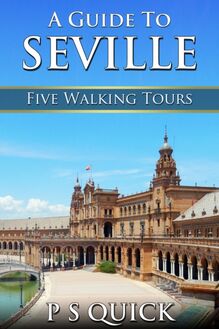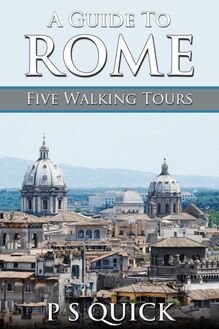Guide to Rome , livre ebook
47
pages
English
Ebooks
2016
Vous pourrez modifier la taille du texte de cet ouvrage
Obtenez un accès à la bibliothèque pour le consulter en ligne En savoir plus
Découvre YouScribe en t'inscrivant gratuitement
Découvre YouScribe en t'inscrivant gratuitement
47
pages
English
Ebooks
2016
Vous pourrez modifier la taille du texte de cet ouvrage
Obtenez un accès à la bibliothèque pour le consulter en ligne En savoir plus
Publié par
Date de parution
07 mars 2016
Nombre de lectures
0
EAN13
9781785384240
Langue
English
Poids de l'ouvrage
1 Mo
Publié par
Date de parution
07 mars 2016
Nombre de lectures
0
EAN13
9781785384240
Langue
English
Poids de l'ouvrage
1 Mo
Title Page
A Guide to Rome
Five Walking Tours
P S Quick
Publisher Information
Published in 2016 by
AUK Academic
an imprint of
Andrews UK Limited
www.andrewsuk.com
Copyright © 2016 P S Quick
The right of P S Quick to be identified as the Author of this Work has been asserted in accordance with the Copyright, Designs and Patents Act 1998
All rights reserved. No part of this publication may be reproduced, stored in a retrieval system, or transmitted, in any form or by any means without the prior written permission of the publisher, nor be otherwise circulated in any form of binding or cover other than that in which it is published and without a similar condition being imposed on the subsequent purchaser. Any person who does so may be liable to criminal prosecution and civil claims for damages.
All information provided in this guide is correct at the time of publication. If anything is subsequently found to be incorrect, please advise the publishers who will update the text in future editions.
Introduction
This book aims to give the tourist an opportunity to visit and enjoy not only the few major attractions that a tour usually includes but many of the other interesting sights that many people do not see.
By providing five different walking routes and detailed information about each attraction passed it puts a visitor to Rome in charge of the time spent at any particular place rather than having to rush and keep up with a guide.
With detailed instructions of how to get from one place to another, including the nearest metro stations for the beginning and end of each walking tour, it gives a flavour of the many things that Rome has to offer without having to join costly guided tours.
Preparation Before arriving in Rome it advisable to consider which tickets will need to be bought in order to go into attractions. Many of these major sights have long queues just to buy tickets and in the height of the tourist season buying tickets on the day can result in queueing for hours. It is possible to buy many tickets on the internet before travelling such as those for the Vatican and Colosseum. Tickets for one attraction, for example the Colosseum, often include free entry to other sights. Another option is to buy a Roma Pass which, although initially expensive, is worth more than five times its value in the places that can be visited. It also offers priority entrance to attractions and includes metro and bus fares. The price varies according to the number of days for which the pass is valid. Do your research on tickets and be careful where you buy. The Roma Pass is probably best bought when you are in Rome as it has a time limit. The pass can be bought in Rome from many museums, tourist points and metro stations. Visit a tourist office or kiosk as soon as you can on arrival to pick up details of attractions and opening times together with a free map which is essential in order to get your bearings and understand where places are located. The official online tourist office is at: http://www.turismoroma.it/?lang=en This will provide you with details of where the nearest tourist office is to your hotel as well as other information. Hotels usually have free maps for their clients. Check opening times and consider the day of the week when choosing a particular walking tour. Some attractions are closed on Mondays although the Capitoline Museums are open every day while the Vatican is closed on Sundays. Often the last admission is one hour before closing time. If you want more detailed information than is given in this book you can choose to hire an audio guide for places like the Colosseum. It is also possible to download free audio guides for your iPod or mp3 player from the internet. While it is wonderful to sit and enjoy a drink or a meal in the busy piazzas this is often costly and if you are on a budget you will find some good quality competitive restaurants off the main streets. Ask the hotel where the locals eat for the best deals. While the walking tours give advice on where to get the metro for travelling around Rome this may not be the best option for you. Some parts of Rome are not close to the metro so a bus may be more appropriate. It is also important to remember that if you walk from one place to another you will see far more than if you travel by public transport. If you are walking long distances you need sensible shoes. Rome is built upon seven hills so if you have mobility problems then walking tours may not be suitable as the tourist is often faced with steps or steep roads. If you are fit enough to do it then walking around Rome is rewarding. When visiting churches remember to dress appropriately or you may be refused entry.
The First Tour
Today’s walk begins at the Piazza Barberini and ends at the Piazza del Popolo. Both of these piazzas have metro stations on Line A.
Main Sights Piazza Barberini Santi Vincenzo e Anastasio Trevi Fountain Piazza Colonna Tempio di Adriano Chiesa di Sant’Ignazio di Loyola Piazza Navona Pantheon Palazzo Altemps Iglesia de Sant’Agostino Borghese Palace Piazza di Spagna Spanish Steps Piazza del Popolo
Piazza Barberini
The Piazza Barberini is a large square located at the confluence of several streets on the Quirinal Hill. It was named after the Barberini family who made their home here. One of the sons became Pope Urban VIII.
Barberini Palace
The architect Maderno started the construction of the Palazzo Barberini in 1627 but died two years later. Bernini took over and completed it in 1633. The palace still stands in the square and now houses the Galleria Nazionale d’Arte Antica , the Museum of Modern Art. It has a superb collection of Renaissance and Baroque paintings.
Fontana del Tritone
Bernini was also responsible for creating the Baroque Fountain of the Triton for Pope Urban VIII in 1643. Four dolphins are paired and hold a coat of arms, two keys and a papal tiara. The sea god, Triton, sits on one clam shell and sips water from another. The bees on the Barberini coat of arms can also be seen in Saint Peter’s Basilica.
Leave Piazza Barberini and walk west along Via del Tritone. After about 350 metres turn left onto Via della Panetteri; walk for 10 metres then straight ahead onto Via della Stamperia. After 210 metres turn left onto Vicolo dei Modelli. After 43 metres you will see the church of St. Vincent and Anastasius.
Santi Vincenzo e Anastasio
This small Baroque church situated near the Trevi fountain was given to the Bulgarian Orthodox Church by Pope John Paul II in 2002. It is worth a visit to see the list of the 22 popes who served from 1583 to 1903 on the left of the altar. Entry is free.
The hearts of these popes still remain in the marble urns kept in this church. It was the custom to remove internal organs to prevent decay while the funeral arrangements were made. The church also contains a large collection of offerings left by people who believed their prayers had been answered.
On leaving the church you will see the Trevi Fountain directly ahead.
Trevi Fountain
The famous Trevi Fountain is the most beautiful fountain in Rome and was featured in Fellini’s film La Dolce Vita. It is the largest Baroque fountain in Rome and derives its name from Tre Vie which refers to the three roads that meet at this point.
It is said that if you throw a coin into the fountain you will definitely return to Rome. Looking away from the fountain the coin should be tossed over the opposite shoulder to the hand holding the coin.
A smaller fountain was built here in the fifteenth century fed by the Agua Virgo, an aqueduct built by Agrippa in 10 BC. In the eighteenth century Pope Clement XII commissioned Nicola Salvi to create a larger fountain to replace it.
The Trevi Fountain
The fountain was built against the wall of the Palazzo Poli and designed like a monumental triumphal arch by Nicola Salvi who was inspired by Bernini’s style of architecture. The sea god Neptune stands in the centre riding upon a shell shaped chariot pulled by two horses that represent the changing moods of the sea; one horse restless while the other is obedient. The water flows loudly over the rocks into a large semi-circular basin representing the sea.
Walk west on Piazza di Trevi towards Vicolo del Forno for 18 metres then continue onto Via delle Muratte. After 200 metres turn right onto Via del Corso and after 130 metres left onto Piazza Colonna.
Piazza Colonna
The Piazza Colonna is a square in central Rome just off the main shopping street known as Via del Corso. It takes its name from the huge marble column that stands there and also contains several other important buildings. On the south side is the Palazzo Ferraioli which used to the Papal Post Office. The Palazzo Wedekind stands on the west side of the Piazza and has Roman columns from the ancient city of Veii. The Temple of Marcus Aurelius once stood on this spot. Next to it is the little church of Santi Barolomeo e Alessandro dei Bergamaschi.
Colonna di Marco Aurelio
The Doric Column of Marcus Aurelius built to celebrate the victories of Emperor Marcus Aurelius’s military campaigns against the Sarmatians and Germanic tribes was completed in 193 AD.
It is just less than thirty



